Verizon Prepaid Tablet Plans

Overview
Verizon Prepaid decided to decouple its Tablet plans from the bundled Data offerings—which previously included Hotspots and Routers—to create a dedicated pricing structure tailored to tablet users. This shift aimed to reduce user confusion, unlock pricing flexibility, and bring the prepaid experience closer in line with Verizon’s postpaid offerings.
We were tasked with designing and implementing the end-to-end digital experience for the new Tablet plans. This included auditing existing user flows to identify pain points, introducing new navigation and plan logic, and updating Verizon’s Design System across mobile and desktop. The work balanced technical complexity with user clarity, enabling a smoother transition for legacy users while improving retention and positioning Verizon more competitively in the prepaid market.
Verizon Prepaid decided to decouple its Tablet plans from the bundled Data offerings—which previously included Hotspots and Routers—to create a dedicated pricing structure tailored to tablet users. This shift aimed to reduce user confusion, unlock pricing flexibility, and bring the prepaid experience closer in line with Verizon’s postpaid offerings.
We were tasked with designing and implementing the end-to-end digital experience for the new Tablet plans. This included auditing existing user flows to identify pain points, introducing new navigation and plan logic, and updating Verizon’s Design System across mobile and desktop. The work balanced technical complexity with user clarity, enabling a smoother transition for legacy users while improving retention and positioning Verizon more competitively in the prepaid market.


My role
- Led a comprehensive audit to identify how new pricing rules would impact existing user flows and legacy plan holder
- Mapped pain points, use cases, and designed new flows to support the updated service offerin
- Developed and extended Verizon’s visual design system to support complex pricing logic and plan structure
- Presented design explorations and final solutions to cross-functional stakeholders for alignment and implementation
Design Team (AKQA)
Arjun Kumar (me) – Sr. Product Designer
Courtney Schiffres – Associate Copy Director
Emily Pan – Sr. UX Designer
Hoon Oh – Associate UX Director
Krista Harder – Copywriter
Arjun Kumar (me) – Sr. Product Designer
Courtney Schiffres – Associate Copy Director
Emily Pan – Sr. UX Designer
Hoon Oh – Associate UX Director
Krista Harder – Copywriter
Final Designs &
user flows
user flows

UX Approach and Plan
We began by unpacking the brief and auditing Verizon’s complex ecosystem — spanning multiple platforms, entry points, user types, plan combinations, and discount rules. This helped us understand how the new tablet pricing would impact existing flows and what new ones we needed to design. From this audit, we identified three key user flows — BYOD, Shop, and Merge — each requiring its own flow logic and discount eligibility strategy.

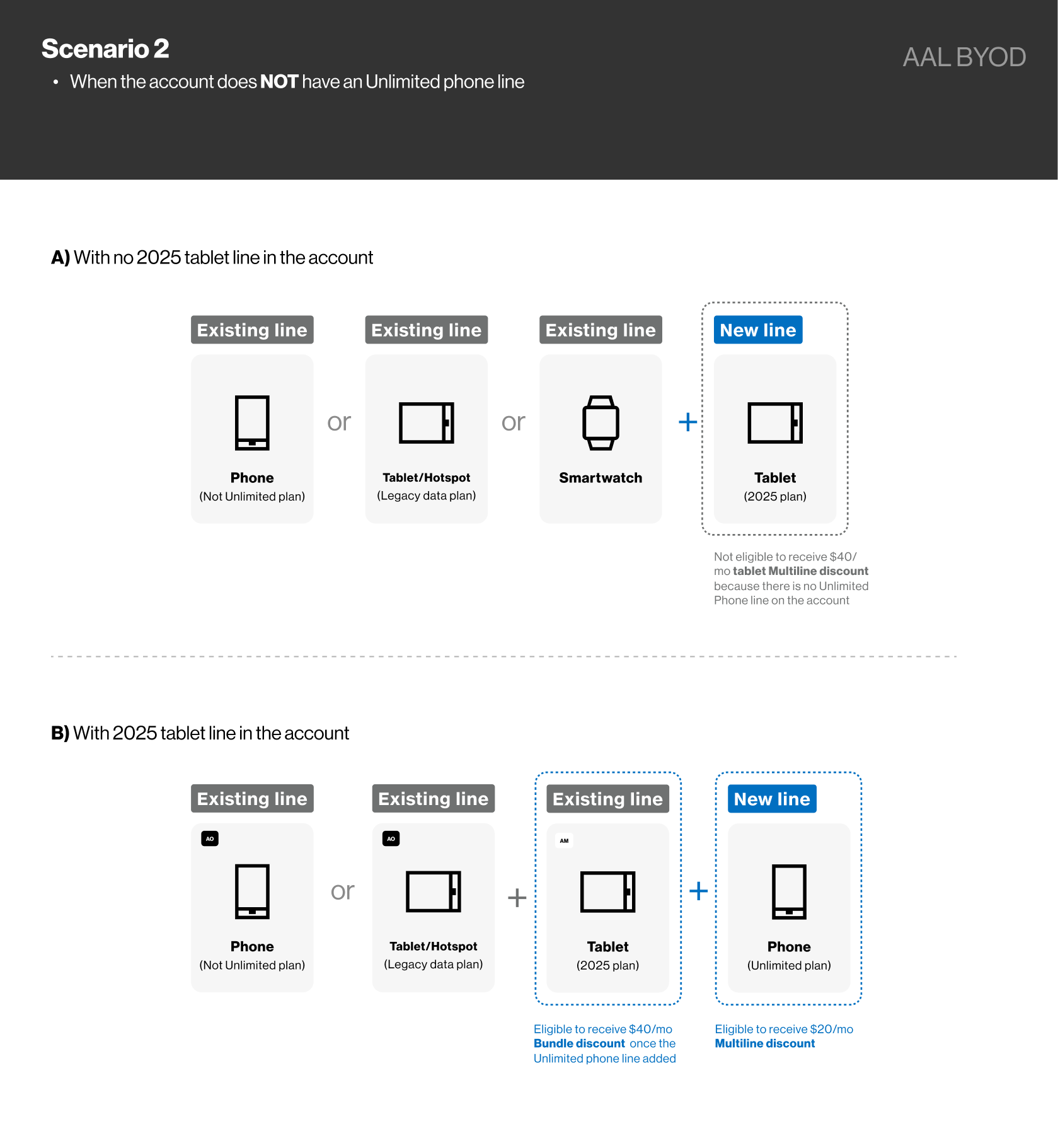
1. Bring Your Own Device (BYOD) flow
The BYOD flow lets users activate a new Verizon Prepaid tablet line using their own device. We defined two key discount scenarios:
The BYOD flow lets users activate a new Verizon Prepaid tablet line using their own device. We defined two key discount scenarios:
- If the account has an Unlimited phone line → Eligible for $40/mo bundle discount on the tablet.
- If not → No discount initially. But if the user later adds an Unlimited phone, they unlock both the $40 tablet bundle and a $20 multiline discount on the phone.



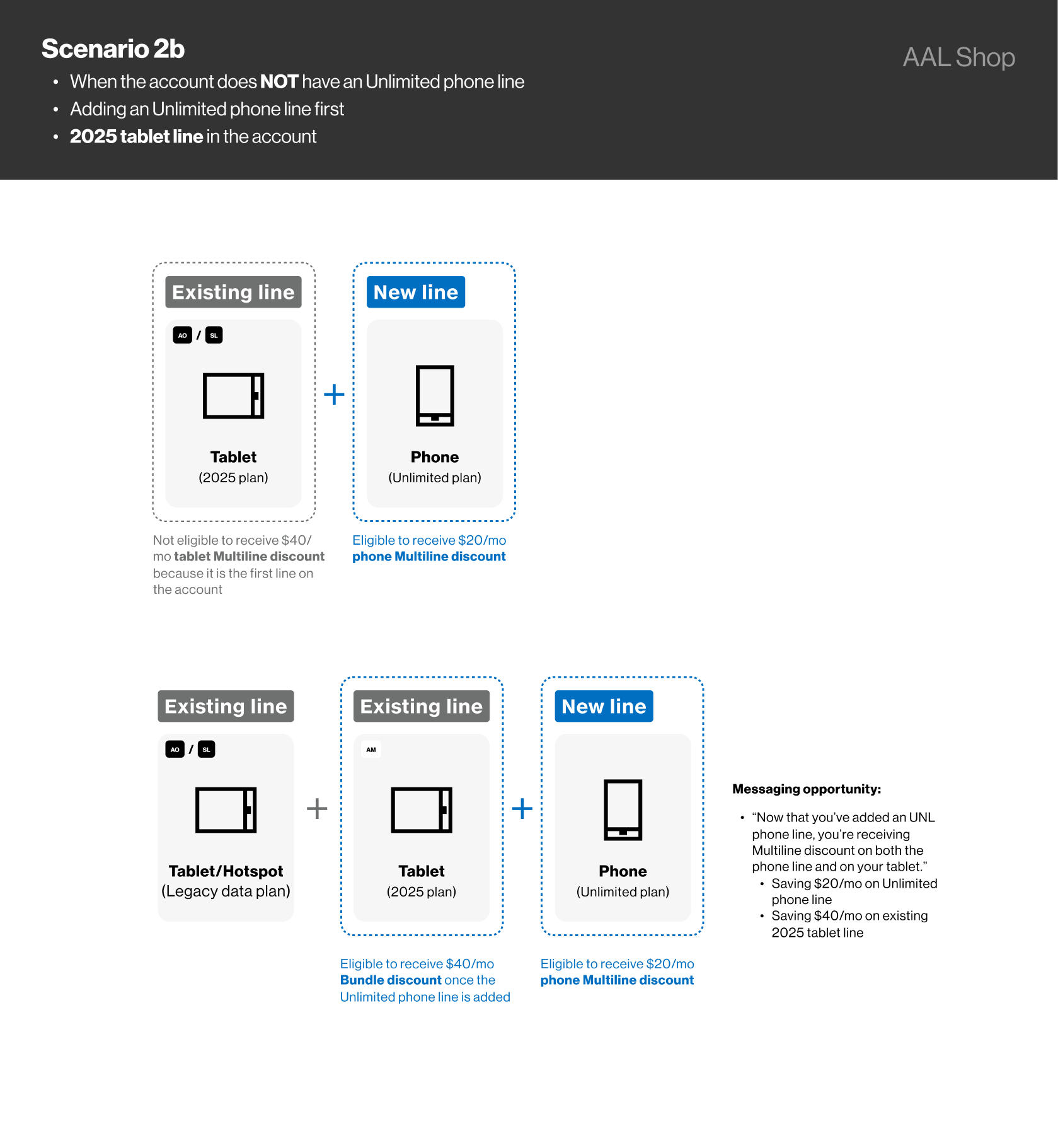
2. Shop flow
The Shop flow allows users to activate a new line or add a device — like a smartphone, tablet, or accessory — through Verizon’s online store. We mapped multiple discount scenarios based on the sequence in which devices are added:
The Shop flow allows users to activate a new line or add a device — like a smartphone, tablet, or accessory — through Verizon’s online store. We mapped multiple discount scenarios based on the sequence in which devices are added:
- If a user adds a Tablet to an account with an Unlimited phone line, they get a $40/month bundle discount.
- If a Tablet is added first (without an Unlimited phone line), the user is not eligible for any discount until they add an Unlimited phone.
- If a user starts by adding an Unlimited phone line, they’re eligible for the $20/month multiline discount, and can later add a Tablet and receive the $40 bundle discount.
- If the first line is a smartwatch, no discounts are applied — even after adding a phone — due to bundle eligibility rules.



3. Merge flow
The Merge flow applies when a user moves a line from another account — either with or without a device upgrade — or ports in a number from another carrier.
We mapped three key scenarios based on whether the user is merging a legacy tablet line or a 2025 tablet line, and whether their account includes an Unlimited phone line:
The Merge flow applies when a user moves a line from another account — either with or without a device upgrade — or ports in a number from another carrier.
We mapped three key scenarios based on whether the user is merging a legacy tablet line or a 2025 tablet line, and whether their account includes an Unlimited phone line:
- Merging a legacy tablet with an Unlimited phone line → Eligible for a $30/month legacy tablet multiline discount
- Merging a 2025 tablet with an Unlimited phone line → Eligible for a $40/month bundle discount
- If the account lacks an Unlimited phone line, users are not eligible for tablet discounts until an Unlimited phone is added.
A robust design system
As part of this project, we took the opportunity to update the long-pending visual design language of the Verizon Prepaid app. In close collaboration with Verizon’s internal design team, I created a scalable atomic design system—building from foundational components to more sophisticated, reusable UI elements used across multiple flows. The system was crafted to meet WCAG AA accessibility standards and was designed with scalability in mind, ensuring it could adapt across device types, future flows, and a wide range of use and edge cases beyond just this project.
As part of this project, we took the opportunity to update the long-pending visual design language of the Verizon Prepaid app. In close collaboration with Verizon’s internal design team, I created a scalable atomic design system—building from foundational components to more sophisticated, reusable UI elements used across multiple flows. The system was crafted to meet WCAG AA accessibility standards and was designed with scalability in mind, ensuring it could adapt across device types, future flows, and a wide range of use and edge cases beyond just this project.
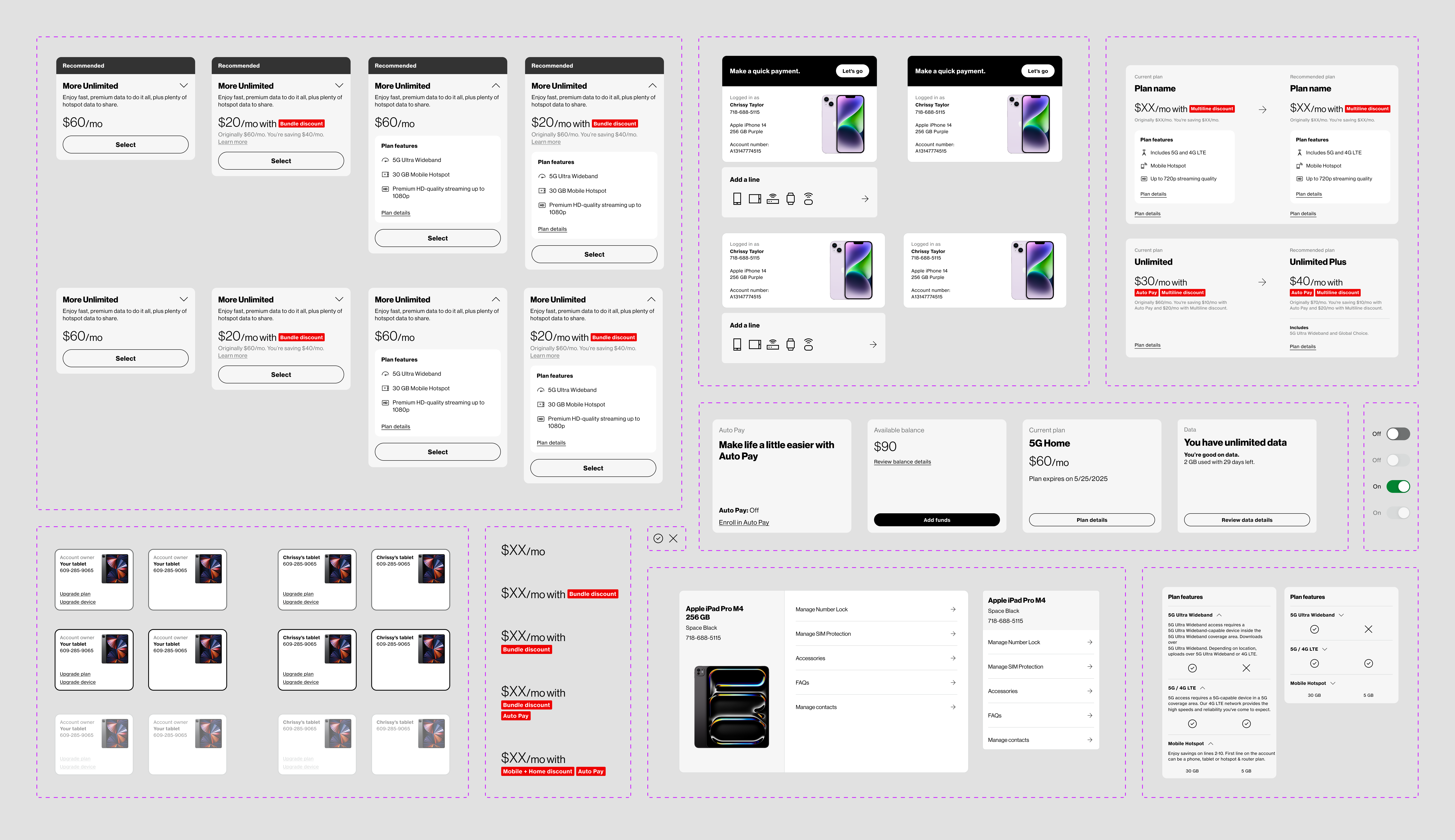


Usability tests & iterations
I conducted internal usability tests with my team to evaluate and refine the designs. The goal was to assess the clarity, completion, and overall comprehension of key features—ensuring users could easily understand and navigate the new flows.
I conducted internal usability tests with my team to evaluate and refine the designs. The goal was to assess the clarity, completion, and overall comprehension of key features—ensuring users could easily understand and navigate the new flows.
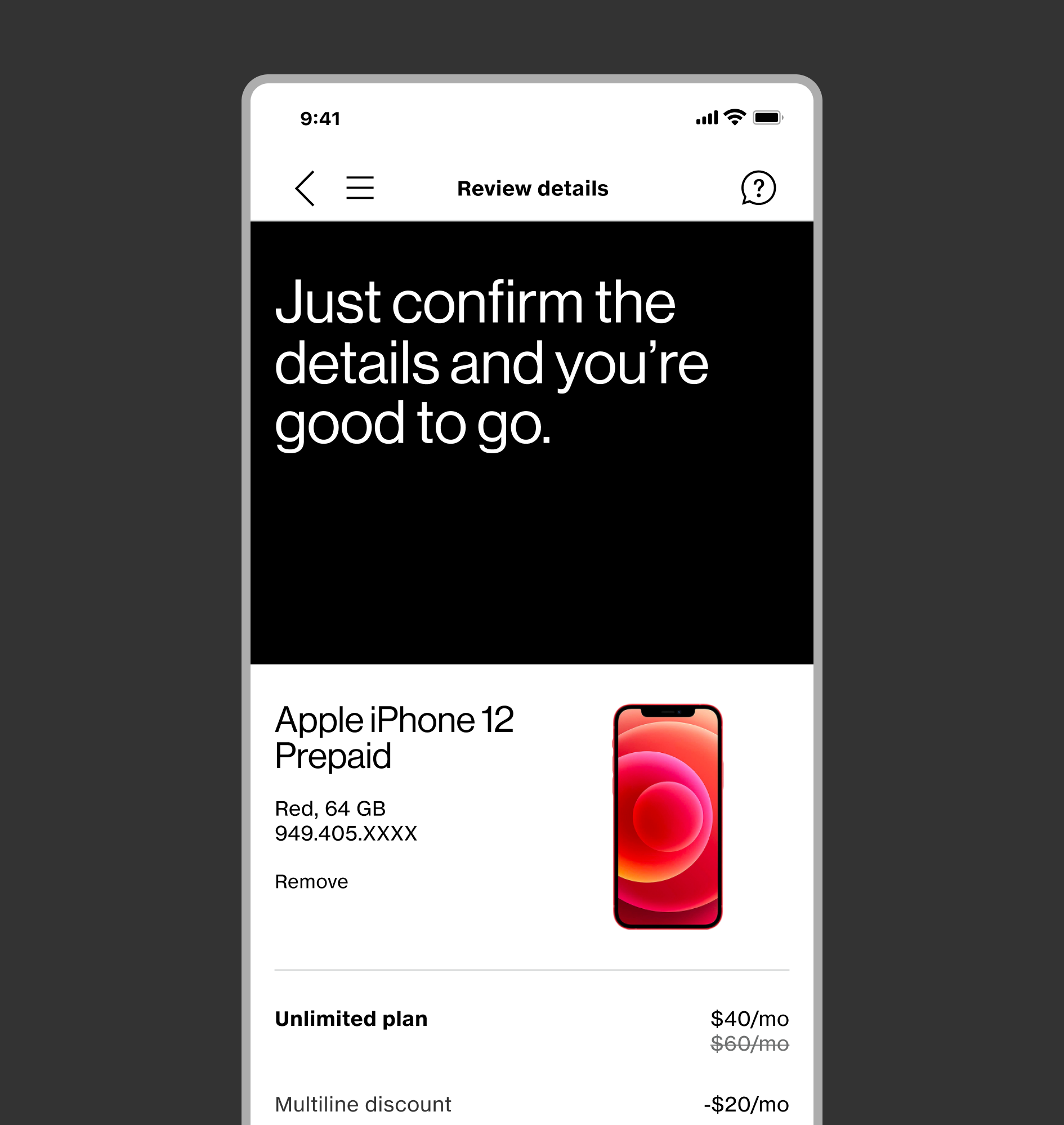 Before
BeforeKey plan and device details were difficult to scan quickly, with important information pushed below the fold.
 After
AfterConsolidated content into a single tile and reorganized layout to surface essential info above the fold for quicker review.
 Before
BeforeThe plan tile lacked visual hierarchy, making the discount and value proposition easy to overlook.
 After
AfterEnhanced the tile design to highlight the discounted price and offer more clearly, improving scannability and user confidence in selection.
 Before
BeforeThe order tracking layout was sparse and the timeline was unclear, making it hard to follow package progress at a glance.
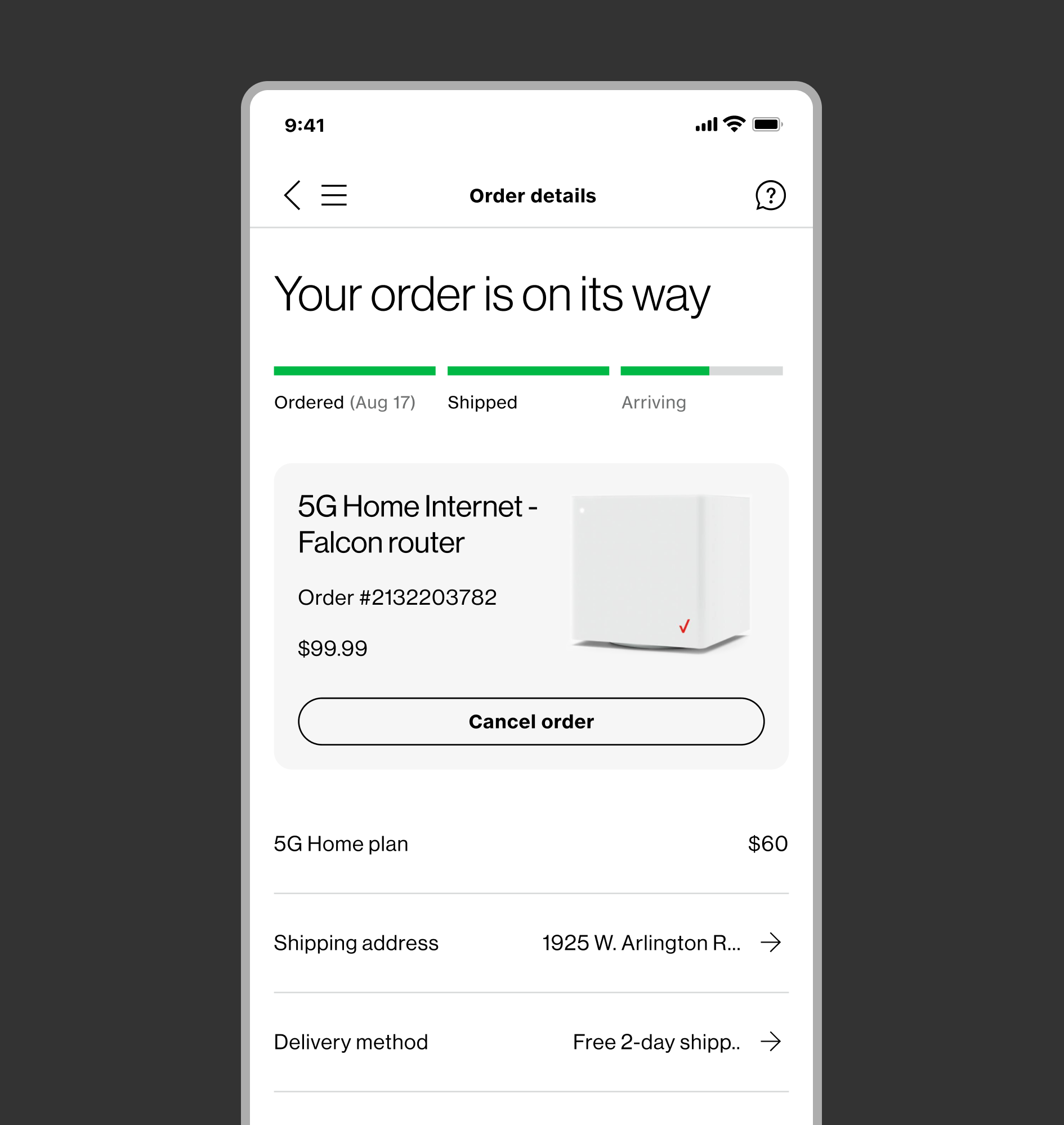 After
AfterIntroduced a stepper-style timeline for better visibility into shipment status and consolidated key order details into a single, scannable tile.
Lessons learned
- Working within Verizon’s vast and layered ecosystem—spanning device types, legacy plans, discount structures, and multiple digital entry points—highlighted the importance of scalable workflows. To manage the complexity, we created a master source component, a centralized discount logic matrix, and a rulebook for business requirements. This not only streamlined this project but also improved efficiency across future initiatives.
- We also learned the value of proactively closing information gaps. When the initial client brief lacked key business rules, we paused execution and introduced a question tracker. By clearly documenting open issues and assigning ownership, we created accountability and ensured we weren’t designing around assumptions.